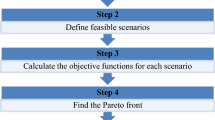Abstract
In this paper, we establish an exact expression of the dynamic traffic assignment (DTA) problem with simultaneous departure time and route (SDR) choices in transportation networks with bottlenecks, where both link and path capacities are time-dependent. Using this expression, closed form of dynamic user equilibrium solutions can be obtained in some special networks. Furthermore, we investigate the DTA-SDR problem in the classical Braess’s network with closed form equilibrium solutions. The explicit results show that an inappropriately added new link could deteriorate the existing network in terms of the increase of individual and system travel costs. The mechanism of this new paradox is quite different from that of the previously discovered ones, and it is the first paradox caused by the simultaneous departure time/route competitions among individuals.
Similar content being viewed by others
References
Akamatsu T (2000) A dynamic traffic equilibrium assignment paradox. Transp Res 34B:515–531
Akamatsu T (2001) An efficient algorithm for dynamic traffic equilibrium assignment with queues. Transp Sci 35:389–404
Arnott R, Small K (1994) The economics of traffic congestion. Am Sci 82:446–455
Arnott R, Palma AD, Lindsey R (1993) Properties of dynamic traffic equilibrium involving bottlenecks, including a paradox and metering. Transp Sci 27:148–160
Ben-Akiva M, Bierlaire M, Koutsopoulos H, Mishalani R (1998) Dynamit: a simulation-based system for traffic prediction. Paper presented at the DACCORD short-term forecasting workshop, Delft, The Netherlands
Braess D (1968) Uber ein paradoxen der verkehrsplaning. Unternehmensforschung 12:258–268
Carey M (1986) A constraint qualification for a dynamic traffic assignment model. Transp Sci 20:55–58
Carey M (1987) Optimal time-varying flows on congested networks. Oper Res 35:58–69
Chen H-K, Hsueh C-F (1998) A model and an algorithm for the dynamic user optimal route choice problem. Transp Res 32B:219–234
Daganzo C (1996) Two paradoxes of traffic flow on networks with physical queues. II Symposium Ingenieria de los Transportes. Madrid, 22–24 May 1996, pp 55–62
Daganzo C (1998) Queue spillovers in transportation networks with a route choice. Transp Sci 32:3–11
Friesz TL, Bernstein D, Smith TE, Tobin RL, Wie BW (1993) A variational inequality formulation of the dynamic network user equilibrium problem. Oper Res 41:179–191
Heydecker BG, Addison JD (1996) An exact expression of dynamic traffic equilibrium. In Lesort J-B (ed) Proceeding of 13th international. Symposium on transportation and traffic theory. Elsevier, pp 359–383
Heydecker BG, Addison JD (2005) Analysis of dynamic traffic equilibrium with departure time choice. Transp Sci 39(1):39–57
Huang HJ, Lam WHK (2002) Modeling and solving the dynamic user equilibrium route and departure time choice problem in network with queues. Transp Res 36B:253–273
Hurdle VF (1974) The effect of queuing on traffic assignment in a simple road network. In Proceedings of the 6th international symposium on transportation and traffic theory, Elsevier Science, Amsterdam, The Netherlands, pp 519–540
Janson BN (1991) Dynamic traffic assignment for urban road networks. Transp Res 25B:143–161
Janson BN, Robles J (1995) A quasi-continuous dynamic traffic assignment model. Transp Res Rec 1493:199–206
Jayakrishnan R, Hu HSMTU (1994) An evaluation tool for advanced traffic information and management systems in urban networks. Transp Res 2C:129–147
Lo HK, Szeto WY (2002) A cell-based variational inequality formulation of the dynamic user optimal assignment problem. Transp Res 36B:421–443
Luque FJ, Friesz TL (1980) Dynamic traffic assignment considered as a continuous time optimal control problem. In: Paper presented at the TIMS/ORSA Joint National Meeting. May 5–7
Mahmassani H, Sbayti H, Chiu Y (2002) Dynasmart-p version 0.930.0 user’s guide, Technical report, Maryland Transportation Initiative, University of Maryland
Merchant DK, Nemhauser GL (1978a) A model and an algorithm for the dynamic traffic assignment problems. Transp Sci 12:183–199
Merchant DK, Nemhauser GL (1978b) Optimality conditions for a dynamic traffic assignment model. Transp Sci 12:200–207
Pas EI, Principio SL (1997) Braess’s paradox: some new insights. Transp Res 31B:265–276
Penchina CM (1997) Braess paradox: maximum penalty in a minimal critical network. Transp Res 31A:379–388
Ran B, Boyce D (1996) A link-based variational inequality formulation of ideal dynamic user optimal route choice problem. Transp Res 4C:1–12
Ran B, Hall RW, Boyce D (1996) A link-based variational inequality model for dynamic departure time/route choice. Transp Res 30B:31–46
Small KA (1982) The scheduling of consumer activities: work trips. Am Econ Rev 72:467–479
Smith MJ (1993) A new dynamic traffic model and the existence and calculation of dynamic user equilibrium on congested capacity-constrained road networks. Transp Res 27B:49–63
Szeto WY, Lo HK (2004) A cell-based simultaneous route and departure time choice model with elastic demand. Transp Res 38B:593–612
Wie BW, Friesz TL, Tobin RL (1990) Dynamic user optimal traffic assignment on congested multi-destination networks. Transp Res 24B:431–442
Wie BW, Tobin RL, Carey M (2002) The existence, uniqueness and computation of an arc-based dynamic network user equilibrium formulation. Transp Res 36B:897–918
Yagar S (1970) Analysis of the Peak Period Travel in a Freeway-Arterial Corridor. Ph.D. Dissertation, University of California, Berkeley
Yagar S (1971) Dynamic traffic assignment by individual path minimization and queueing. Transp Res 5:179–196
Yagar S (1974) Emulation of dynamic equilibrium in traffic networks. In Florian MA (ed) Traffic equilibrium methods, Lecture notes in economics and mathematical systems, volume 118, Springer-Verlag
Yang H (1997) Sensitivity analysis for the elastic-demand network equilibrium problem with applications. Transp Res 31B:55–70
Yang H, Bell MGH (1998) A capacity paradox in network design and how to avoid it. Transp Res 32A:539–545
Zhang XN, Zhang HM (2005) Paradoxes of network expansion considering dynamic user response. Transportation research board 84th annual meeting. Washington D.C., 12–16 January 2005
Author information
Authors and Affiliations
Corresponding author
Rights and permissions
About this article
Cite this article
Zhang, X., Zhang, H.M. Simultaneous Departure Time/Route Choices in Queuing Networks and a Novel Paradox. Netw Spat Econ 10, 93–112 (2010). https://doi.org/10.1007/s11067-007-9026-7
Published:
Issue Date:
DOI: https://doi.org/10.1007/s11067-007-9026-7




